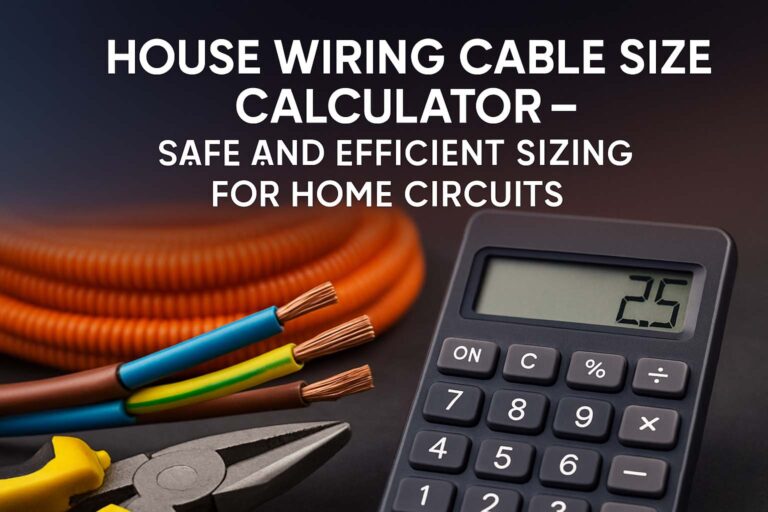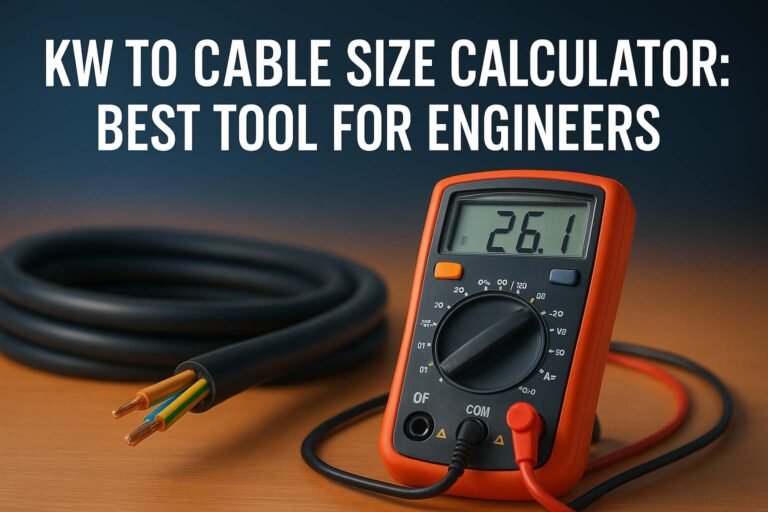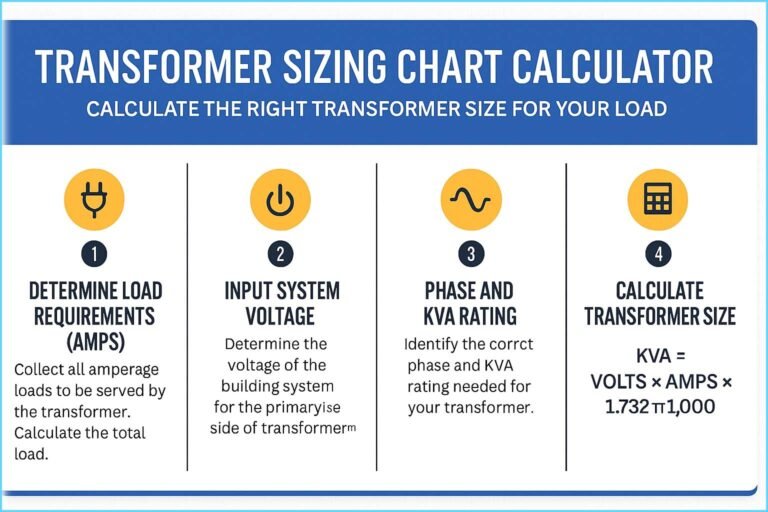KW to KVA and KVA to Amps Calculator – The Ultimate Guide
Understanding electrical power measurements is essential for engineers, electricians, and even homeowners dealing with backup generators or large electrical systems. When working with electricity, you’ll often encounter three important units: kilowatts (kW), kilovolt-amperes (kVA), and amperes (A). Each of these represents a different aspect of electrical power, and converting between them requires some technical understanding. That’s where a KW to KVA and KVA to Amps Calculator comes in handy.
Table of Contents

These calculators are essential tools used in electrical system design, generator sizing, and load planning. Whether you’re specifying a generator for a commercial facility or selecting a transformer for a residential setup, knowing how to switch between kW, kVA, and Amps is crucial. Misunderstanding these units can result in under-sized or over-priced equipment, leading to inefficiencies and safety risks.
In this article, you’ll learn exactly how these conversions work. We’ll explain the math behind them and help you understand how a KW to KVA and KVA to Amps Calculator can save time, ensure accuracy, and support your decisions. Along the way, we’ll include useful formulas, clear tables, and practical examples to keep everything easy to digest.
Key Takeaways:
- KW (kilowatts) represents actual power, while kVA (kilovolt-amperes) includes both real and reactive power.
- Amps (A) measure current, and their relationship to kVA depends on system voltage and phase type.
- A calculator simplifies these conversions and helps avoid manual errors in electrical load planning.
- Power factor (PF) plays a critical role in converting between kW and kVA.
- This article provides formulas, conversion tables, and real-world usage examples.
Use our online tool Watt to Amp Calculator (Single & Three-Phase)
What Is the Difference Between kW, kVA, and Amps?
To understand how a KW to KVA and KVA to Amps Calculator works, it’s important to know what these terms mean.
Kilowatts (kW) refer to real power—the actual usable energy consumed by electrical devices. It is the power that performs real work like running a motor or lighting a bulb.
Kilovolt-amperes (kVA) represent apparent power. This is a combination of real power and reactive power. Reactive power is not consumed but is necessary for maintaining electric and magnetic fields in devices like motors and transformers.
Amperes (A) represent the amount of electric current flowing through a conductor. It is influenced by the system voltage and the type of electrical phase—single or three-phase.
So, while kW tells you what your equipment uses, kVA tells you what your system needs to provide. And Amps show the current drawn in that process. Understanding these relationships is the core of electrical load management.
Why Do You Need a KW to KVA and KVA to Amps Calculator?
If you’re managing electrical infrastructure, you often have to convert between these units. For example, you may know the kW requirement of your machinery but need to find out the generator’s size in kVA. Or you might know the system load in kVA and want to find the current in Amps to size cables and breakers.
Manual calculation is possible, but time-consuming and error-prone. That’s where a KW to KVA and KVA to Amps Calculator becomes useful. With just a few inputs, you can accurately compute your results in seconds.
Use our online tool AWG to mm² Calculator – Convert Wire Sizes Easily and Accurately
Technical Formula Behind KW to KVA Conversion
The conversion from kW to kVA is based on one simple formula:
kVA = kW / Power Factor (PF)
The Power Factor (PF) is a measure of how efficiently electricity is being used. For most industrial applications, it ranges from 0.8 to 0.95. If the power factor is not known, 0.8 is commonly assumed as standard.
Example:
If a system has a real power of 160 kW and a power factor of 0.8:
kVA = 160 / 0.8 = 200 kVA
Here’s a quick conversion table for reference:
| Real Power (kW) | Power Factor | Apparent Power (kVA) |
|---|---|---|
| 100 | 0.8 | 125 |
| 200 | 0.85 | 235.29 |
| 300 | 0.9 | 333.33 |
| 400 | 0.95 | 421.05 |
| 500 | 0.8 | 625 |
This table shows how increasing the power factor reduces the kVA requirement for the same kW.
Technical Formula Behind KVA to Amps Conversion
The formula to convert kVA to Amps depends on the voltage and whether the system is single-phase or three-phase.
Single-Phase Formula:
Amps = (kVA × 1000) / Voltage
Three-Phase Formula:
Amps = (kVA × 1000) / (Voltage × √3)
Let’s look at an example.
Example – Single Phase:
A 50 kVA system at 230V:
Amps = (50 × 1000) / 230 = 217.39 A
Example – Three Phase:
A 50 kVA system at 400V:
Amps = (50 × 1000) / (400 × √3) ≈ 72.17 A
Use our online tool Electrical Conduit Fill Calculator and Conduit Wire Fill Chart
Here’s a quick conversion table for KVA to Amps:
| kVA | Voltage (Single-Phase) | Current (A) |
|---|---|---|
| 10 | 230V | 43.48 |
| 25 | 230V | 108.7 |
| 50 | 230V | 217.39 |
| 75 | 230V | 326.09 |
| kVA | Voltage (Three-Phase) | Current (A) |
|---|---|---|
| 10 | 400V | 14.43 |
| 25 | 400V | 36.08 |
| 50 | 400V | 72.17 |
| 75 | 400V | 108.25 |
These values help in sizing cables, breakers, and other protective equipment.
Where to Use KW to KVA and KVA to Amps Calculators
1. Generator Sizing:
One of the most common uses is in generator sizing. Equipment usually states its load in kW, but generators are rated in kVA. Using the calculator, you can quickly size the correct generator without manual math.
2. Transformer Selection:
Transformers are often specified in kVA. If your load is in kW, the calculator helps you determine what size transformer you’ll need, considering the power factor.
3. Cable and Breaker Sizing:
When current (Amps) is calculated from kVA, it becomes easy to select the right wire size or circuit breaker, especially when designing residential or industrial installations.
4. Load Management:
Engineers use the calculator for load balancing and estimating peak demands in commercial and industrial setups.
Use our online tool Conduit Fill Calculator (NEC Standard) – Understand Conduit Fill and Wire Capacity
Benefits of Using an Online KW to KVA and KVA to Amps Calculator
Saves Time: You don’t have to memorize formulas or use spreadsheets.
Reduces Errors: Avoids calculation mistakes, especially in complex projects.
User-Friendly: Most calculators only require two inputs—simple and effective.
Accuracy: Ensures precise sizing of generators, cables, and switchgear.
Cost-Effective: Helps avoid oversizing or under-sizing, which can lead to increased costs or damage.
Things to Keep in Mind While Using the Calculator
- Always confirm the power factor. A wrong PF can lead to inaccurate results.
- Know the system voltage and whether it’s single-phase or three-phase.
- Do not assume standard values unless specified. Always use actual equipment ratings.
- If in doubt, consult with an electrical engineer to verify the calculator’s outputs.
Common Mistakes People Make
Many people assume kW and kVA are the same. This is incorrect. Not factoring in the power factor leads to wrong generator sizing and cable selection.
Some also apply the wrong formula for single and three-phase systems. The inclusion of √3 (1.732) in the three-phase formula is critical and often overlooked.
Use our online tool House Wiring Cable Size Calculator – Safe and Efficient Sizing for Home Circuits
Final Thoughts on KW to KVA and KVA to Amps Calculator
In today’s world of smart grids, renewable energy, and precision-based electrical design, even small calculation errors can result in big problems. That’s why every professional involved in electrical load planning should keep a KW to KVA and KVA to Amps Calculator in their toolbox. It ensures you’re designing your systems on solid ground—with accurate, reliable, and efficient results.
Follow Us on Social:
Subscribe our Newsletter on Electrical Insights for latest updates from Electrical Engineering Hub
#KWtoKVA, #KVAtoAmps, #PowerCalculator, #ElectricalCalculator, #ElectricalEngineering, #AmpsCalculation, #KVAConverter, #KWConversion, #ElectricLoadCalculator, #ThreePhasePower, #SinglePhaseCalculation, #OnlineCalculator, #PowerFactor, #WattsToAmps, #ElectricalTools
KW to KVA and KVA to Amps Calculator – The Ultimate Guide : Electrical Engineering Hub

Understanding electrical power measurements is essential for engineers, electricians, and even homeowners dealing with backup generators or large electrical systems. When working with electricity, you'll often encounter three important units: kilowatts (kW), kilovolt-amperes (kVA), and amperes (A). Each of these represents a different aspect of electrical power, and converting between them requires some technical understanding. That's where a KW to KVA and KVA to Amps Calculator comes in handy.
Price Currency: USD
Operating System: All
Application Category: UtilitiesApplication






